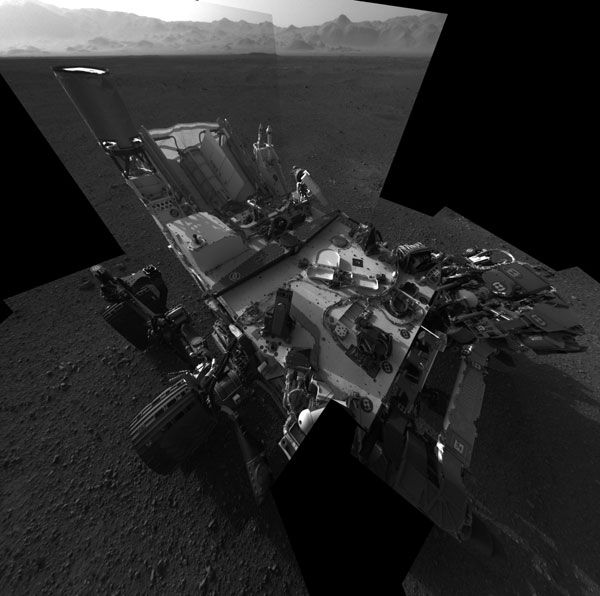Curiosity Update... I recently created the video above which features footage I took with my digital still camera at Planetfest 2012 in the Pasadena Convention Center on August 5. Check it out (I need to buy a real video camera before NASA lands another spacecraft on Mars, hah)— It's pretty much a sequel to the video I made of Phoenix's arrival at the Red Planet back in 2008. Now onto official news pertaining to the Curiosity rover's mission...
****
NASA Curiosity Team Pinpoints Site for First Drive (Press Release - August 17)
PASADENA, Calif. -- The scientists and engineers of NASA's Curiosity rover mission have selected the first driving destination for their one-ton, six-wheeled mobile Mars laboratory. The target area, named Glenelg, is a natural intersection of three kinds of terrain. The choice was described by Curiosity Project Scientist John Grotzinger of the California Institute of Technology during a media teleconference on Aug. 17.
"With such a great landing spot in Gale Crater, we literally had every degree of the compass to choose from for our first drive," Grotzinger said. "We had a bunch of strong contenders. It is the kind of dilemma planetary scientists dream of, but you can only go one place for the first drilling for a rock sample on Mars. That first drilling will be a huge moment in the history of Mars exploration."
The trek to Glenelg will send the rover 1,300 feet (400 meters) east-southeast of its landing site. One of the three types of terrain intersecting at Glenelg is layered bedrock, which is attractive as the first drilling target.
"We're about ready to load our new destination into our GPS and head out onto the open road," Grotzinger said. "Our challenge is there is no GPS on Mars, so we have a roomful of rover-driver engineers providing our turn-by-turn navigation for us."
Prior to the rover's trip to Glenelg, the team in charge of Curiosity's Chemistry and Camera instrument, or ChemCam, is planning to give their mast-mounted, rock-zapping laser and telescope combination a thorough checkout. On Saturday night, Aug. 18, ChemCam is expected to "zap" its first rock in the name of planetary science. It will be the first time such a powerful laser has been used on the surface of another world.
"Rock N165 looks like your typical Mars rock, about three inches wide. It's about 10 feet away," said Roger Wiens, principal investigator of the ChemCam instrument from the Los Alamos National Laboratory in New Mexico. "We are going to hit it with 14 millijoules of energy 30 times in 10 seconds. It is not only going to be an excellent test of our system, it should be pretty cool too."
Mission engineers are devoting more time to planning the first roll of Curiosity. In the coming days, the rover will exercise each of its four steerable (front and back) wheels, turning each of them side-to-side before ending up with each wheel pointing straight ahead. On a later day, the rover will drive forward about one rover-length (10 feet, or 3 meters), turn 90 degrees, and then kick into reverse for about 7 feet (2 meters).
"There will be a lot of important firsts that will be taking place for Curiosity over the next few weeks, but the first motion of its wheels, the first time our roving laboratory on Mars does some actual roving, that will be something special," said Michael Watkins, mission manager for Curiosity from the Jet Propulsion Laboratory in Pasadena, Calif.
The Mars Science Laboratory spacecraft delivered Curiosity to its target area on Mars at 10:31:45 p.m. PDT on Aug. 5 (1:31:45 a.m. EDT on Aug. 6), which included the 13.8 minutes needed for confirmation of the touchdown to be radioed to Earth at the speed of light.
The mission is managed by JPL for NASA's Science Mission Directorate in Washington. The rover was designed, developed and assembled at JPL, a division of Caltech. ChemCam was provided by Los Alamos National Laboratory. France provided ChemCam's laser and telescope.
Source: Jet Propulsion Laboratory
****

NASA / JPL - Caltech

No comments:
Post a Comment